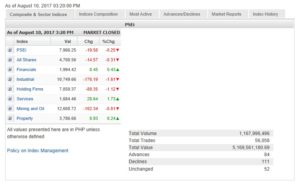Total trade declined while manufacturing growth slowed in June, prompting state planning agency National Economic and Development Authority (Neda) to push for further diversification of export markets.
Preliminary Philippine Statistics Authority (PSA) data showed that merchandise exports in June inched up 0.8 percent year-on-year to $4.91 billion, bringing the first-half exports to $31.04 billion, up 13.6 percent.
Imports fell by 2.5 percent year-on-year to $7.06 billion in June, although the total for the first six months was still up by 9.6 percent year-on-year to $44.22 billion.
In June alone, total trade went down by 1.2 percent year-on-year to $11.97 billion, while trade-in-goods deficit narrowed to $2.15 billion from $2.37 billion a year ago.
The lackluster trade performance in June reversed the double-digit increase in both exports and imports in May.
At the end of the first half, total merchandise trade jumped by 11.2 percent to $75.26 billion, with the trade-in-goods deficit widening to $13.17 billion from $12.99 billion last year.
“We expect Philippine trade to recover, as the global economic recovery is seen to be on firmer footing in the second half of the year,” Socioeconomic Planning Secretary Ernesto M. Pernia said in a statement.
“In tapping new export markets, the country can take advantage of its European Union-Generalized System of Preferences Plus (GSP+) preferential status,” said Pernia, who is also the Neda chief, referring to the tax perks given to Philippine products in the EU.
“In light of our hosting of the Asean Summit this year, our country is in a better position to push for a reduction in nontariff barriers within the region,” Pernia added, saying that nontariff barriers to intra regional trade rose from 1,634 to 5,975 between 2000 and 2015 even as the Asean integration into one economic community was in full swing.
Neda noted the growth in exports to Asean and the EU of 4.8 percent and 3.9 percent, respectively, in June, “cushioned the decline in traditional markets such as the US (down 8.7 percent), Japan (down 9 percent) and China (down 2.4 percent).”
“For Philippine imports, growth in Asean (up 4.5 percent) and the EU (up 0.5 percent) helped offset the decline in imports from the US (down 8.2 percent), China (down 3.7 percent) and Taiwan (down 33.1 percent)” in June, Neda added.
In the meantime, manufacturing growth, as measured by the Volume of Production Index (VoPI) slowed to 8.1 percent in June from 9.8 percent a year ago, the PSA’s Monthly Integrated Survey of Selected Industries showed.
In the first six months, the manufacturing sector expanded by an average of 10 percent, faster than the 9 percent a year ago, on the back of “sustained domestic and improved external demand.”
Pernia said he was bullish about manufacturing sector moving forward.


